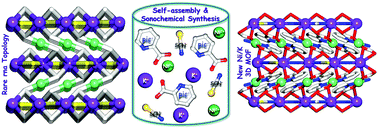A 3D heterometallic Ni(ii)/K(i) MOF with a rare rna topology: synthesis, structural features, and photocatalytic dye degradation modeling†
Abstract
Treatment of Ni(II) acetate with picolinic acid (Hpic) and KSCN resulted in the self-assembly generation of a new heterometallic and heteroleptic 3D metal–organic framework (MOF) formulated as [Ni(μ3-pic)2K(μ-SCN)]n (1). The crystal structure of 1 features a very intricate structure with a rare type of rna topology. This compound extends a still limited family of heterometallic picolinate-driven MOFs and represents the first Ni/K-picolinate derivative. Micro- and nanoscale samples of 1 (hereinafter 1s) were also obtained by a sonochemical irradiation method, wherein the effects of sonication power, reaction time, reactant concentration and temperature on the morphology of 1s were studied. Ultrasonically generated samples of 1s were characterized by standard methods and applied as photocatalysts for the photodegradation of bromocresol green (BCG) in aqueous solution under visible-light, leading to 94% degradation efficiency. The response surface methodology (RSM) with central composite design (CCD) was used for modeling and optimization of photodegradation variables such as pH, irradiation time, the initial BCG concentration, and catalyst dosage.



 Please wait while we load your content...
Please wait while we load your content...